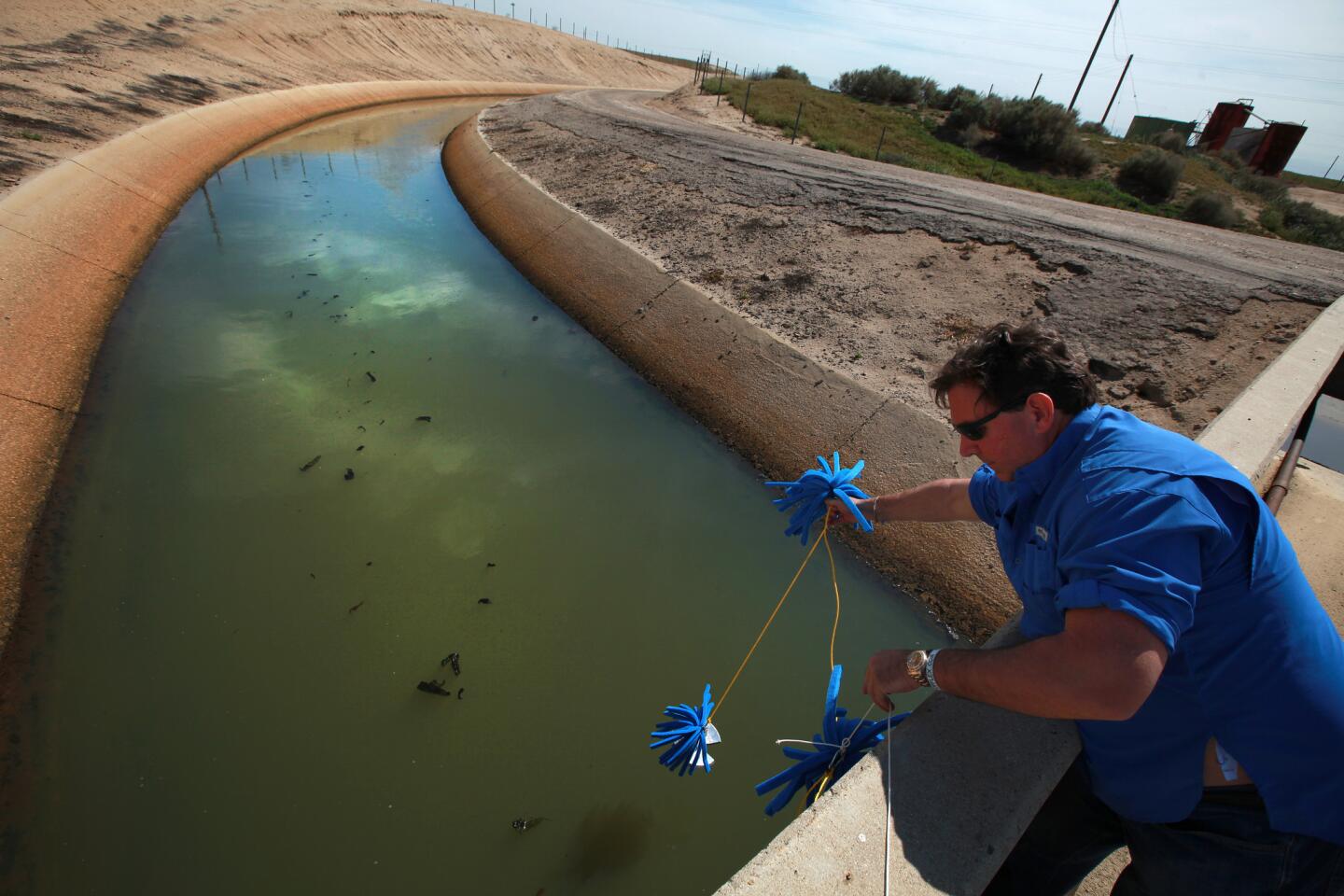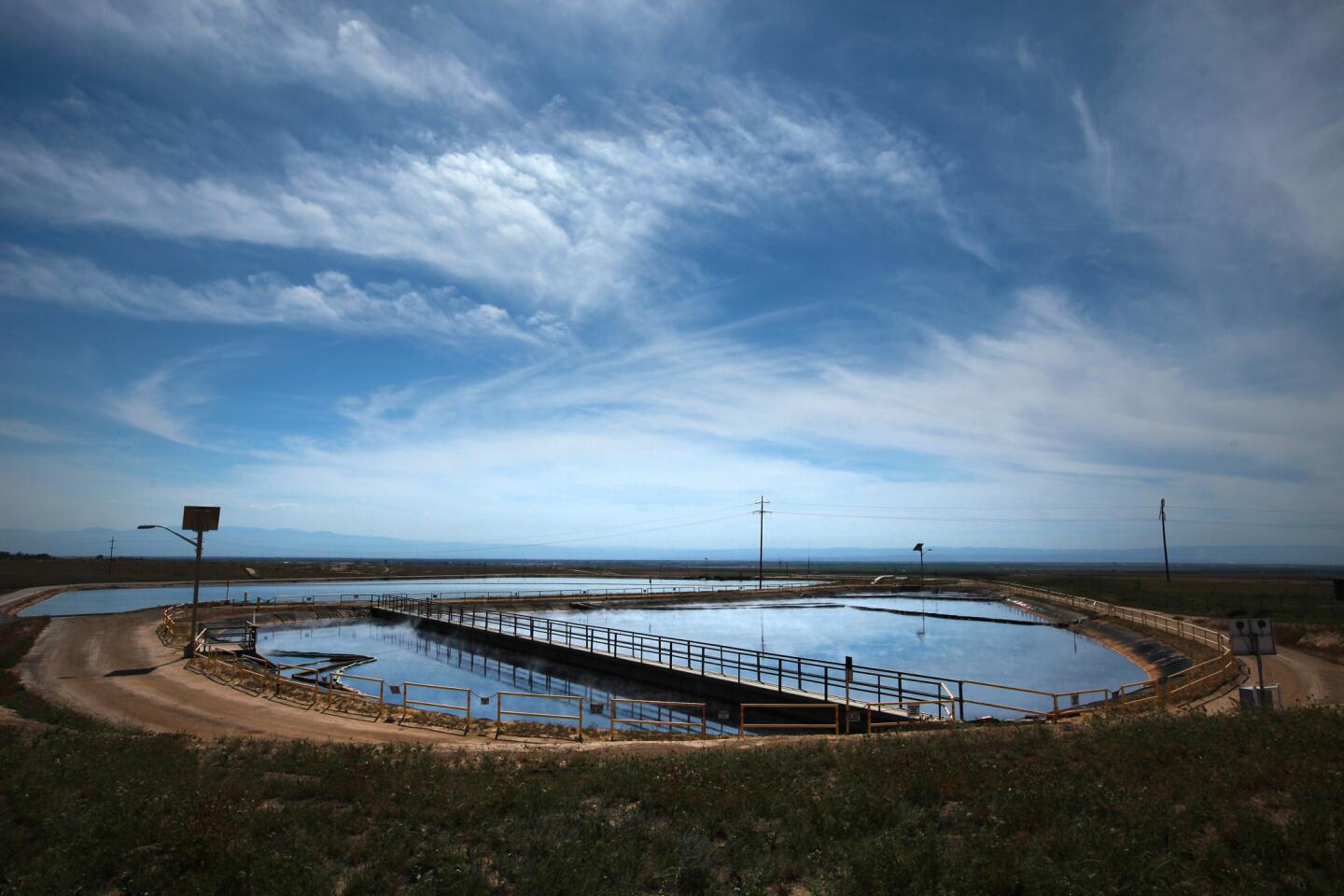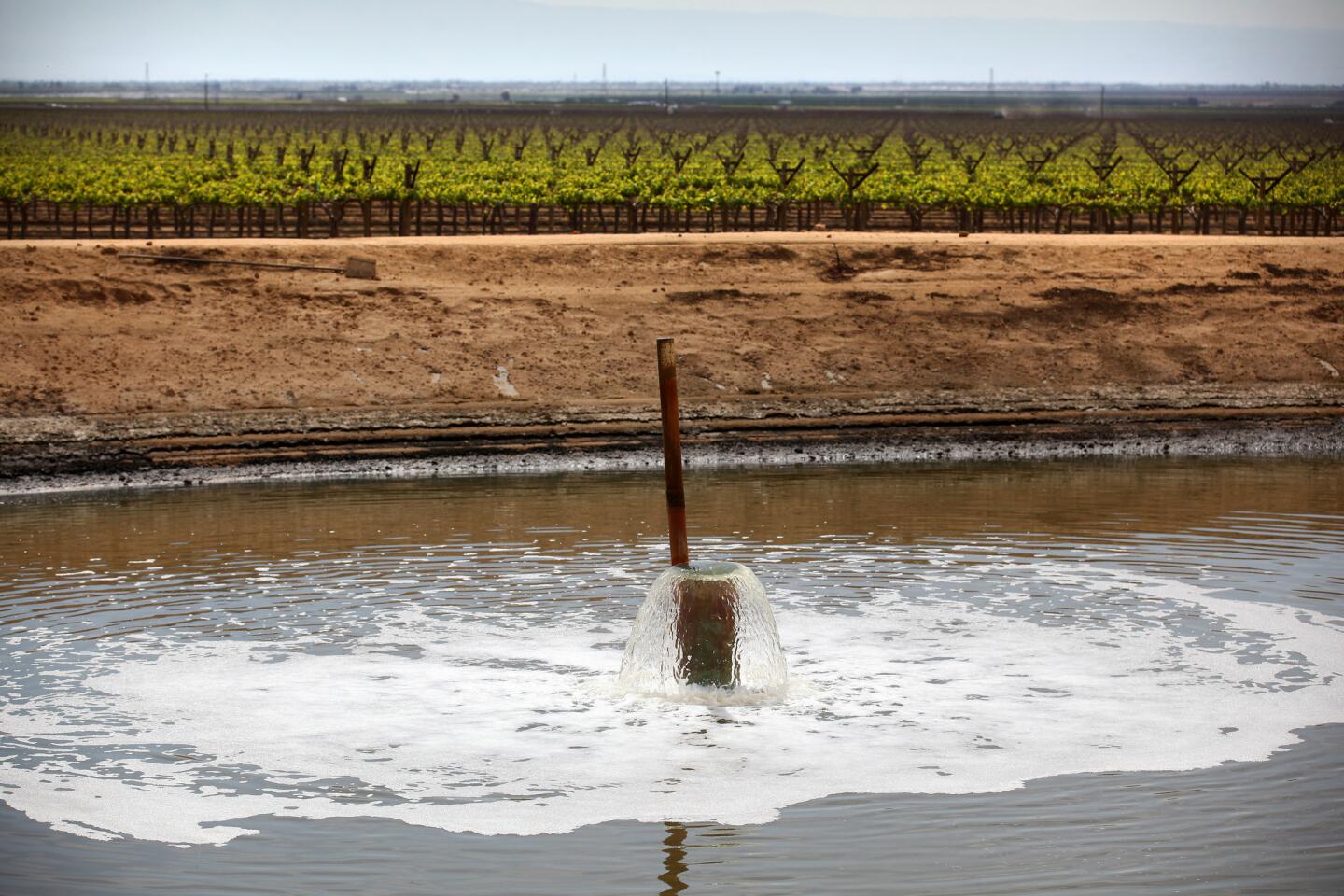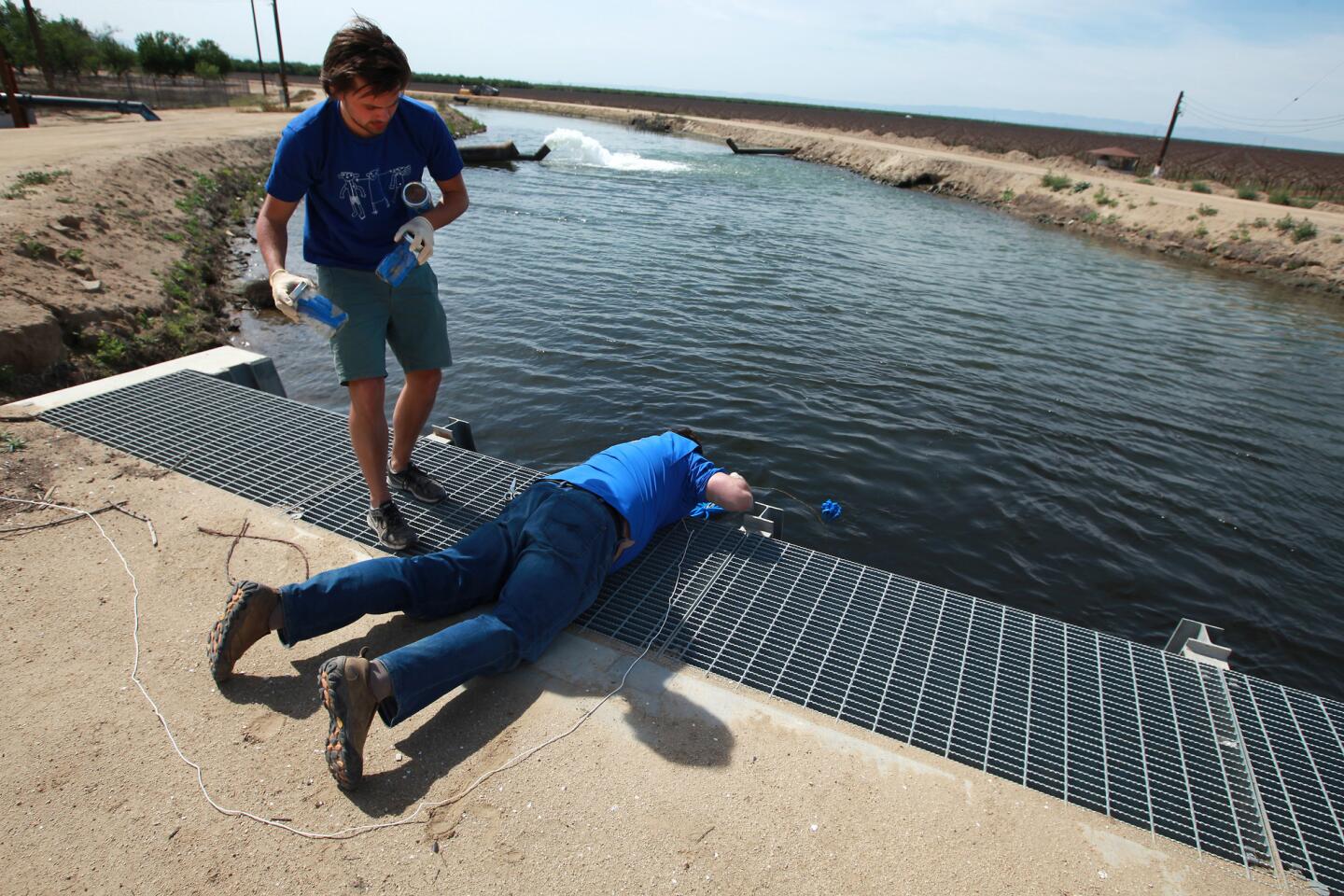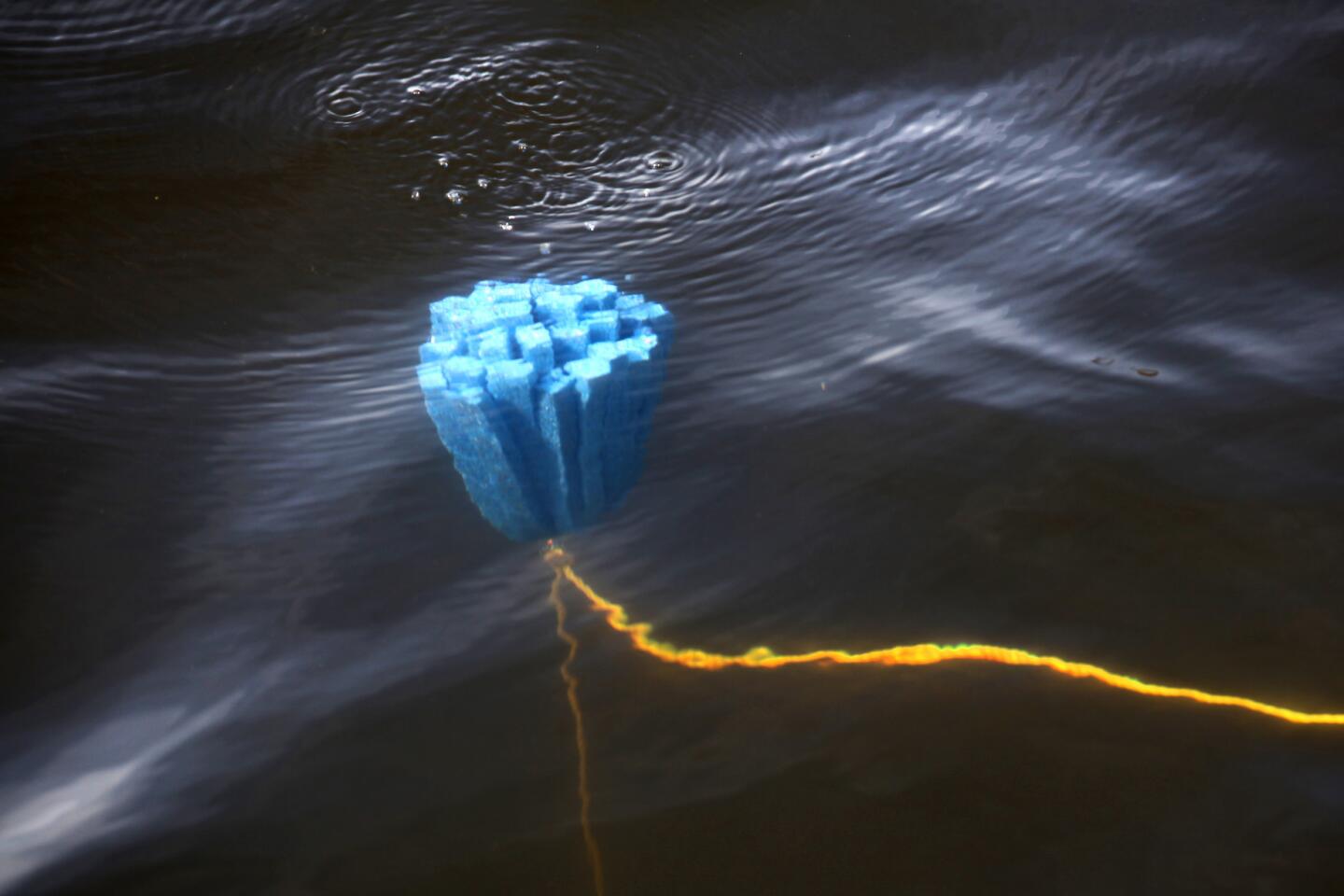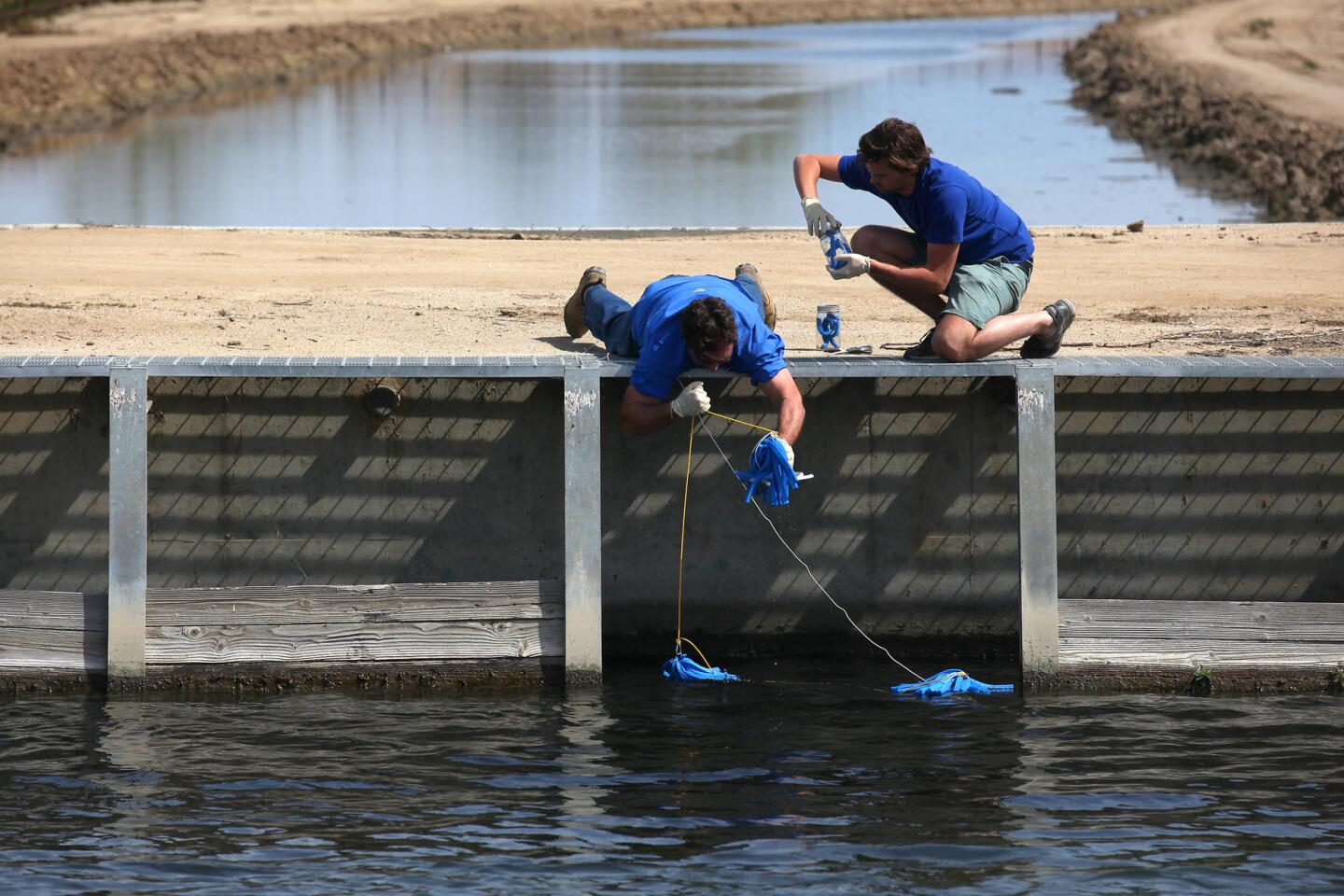Central Valley’s growing concern: Crops raised with oil field water
- Share via
Reporting from BAKERSFIELD — Here in California’s thirsty farm belt, where pumpjacks nod amid neat rows of crops, it’s a proposition that seems to make sense: using treated oil field wastewater to irrigate crops.
Oil giant Chevron recycles 21 million gallons of that water each day and sells it to farmers who use it on about 45,000 acres of crops, about 10% of Kern County’s farmland.
State and local officials praise the 2-decade-old program as a national model for coping with the region’s water shortages. As California’s four-year drought lingers and authorities scramble to conserve every drop, agricultural officials have said that more companies are seeking permits to begin similar programs. The heightened interest in recycling oil field wastewater has raised concern over the adequacy of safety measures in place to prevent contamination from toxic oil production chemicals.
------------
FOR THE RECORD
Oil field water: In the May 3 Section A, an article about the use of recycled oil field water in California agriculture said that samples contained acetone and methylene chloride after treatment. Acetone was found in testing in 2014, but not in a March 2015 test. An accompanying graphic cited the levels of three chemicals found in untreated oil field water: oil, 240,000-480,000 parts per million; acetone, 440-530 parts per billion; and methylene chloride, 82-89 parts per billion. However, the graphic omitted the levels found in tests of treated water: oil, 130-1,300 parts per million; acetone, 57-79 parts per billion; and methylene chloride, 26-56 parts per billion. Also, the source of the untreated water was misidentified. The samples were from the Poso Creek Oil Field, not an oil field owned by Chevron. And Blake Sanden was identified as an agriculture extension agent for UC Davis. Sanden works for the statewide UC Agriculture and Natural Resources program. —
------------
Until now, government authorities have only required limited testing of recycled irrigation water, checking for naturally occurring toxins such as salts and arsenic, using decades-old monitoring standards. They haven’t screened for the range of chemicals used in modern oil production.
No one knows whether nuts, citrus or other crops grown with the recycled oil field water have been contaminated. Farmers may test crops for pests or disease, but they don’t check for water-borne chemicals. Instead, they rely on oversight by state and local water authorities. But experts say that testing of both the water and the produce should be expanded.
Last month, the Central Valley water authority, which regulates the water recycling program, notified all oil producers of new, broader testing requirements and ordered the companies to begin checking for chemicals covered under California’s new fracking disclosure regulations. The law, which legislators approved last year, requires oil companies to tell the state which chemicals they use in oil-extraction processes. The water authority gave producers until June 15 to report their results.
“We need to make sure we fully understand what goes into the wastewater,” said Clay Rodgers, assistant executive officer of the Central Valley Water Quality Control Board.
One environmental group has tested the irrigation water for oil field chemicals. Over the last two years, Scott Smith, chief scientist for the advocacy group Water Defense, collected samples of the treated irrigation water that the Cawelo Water District buys from Chevron. Laboratory analysis of those samples found compounds that are toxic to humans, including acetone and methylene chloride — powerful industrial solvents — along with oil.
Water Defense, founded by actor Mark Ruffalo in 2010, works to promote access to clean water by testing local supplies and documenting contamination.
Sarah Oktay, a water testing expert and director of the Nantucket field station of the University of Massachusetts Boston, reviewed Smith’s methods and the laboratory analysis of the water he sampled.
“I wouldn’t necessarily panic, but I would certainly think I would rather not have that,” she said, referring to the chemicals identified in the water samples. “My next step would be most likely to look and make sure the crop is healthy.”
State Sen. Fran Pavley (D-Agoura Hills) is sponsoring legislation that would require expanded testing of water produced in oil operations. The Division of Oil, Gas & Geothermal Resources, which regulates the state’s oil and gas industry, is already facing lawmakers’ ire after the recent discovery that about 2,500 oil wastewater injection wells were allowed to operate in aquifers that, under federal standards, contain clean water.
Pavley said it is “obviously unacceptable” that oil contaminants are found in irrigation water. “Anyone would be extremely concerned.”
Chevron and the water district say that the water is safe for use on crops, citing the fact that they are complying with testing requirements under the wastewater discharge permit issued by the Central Valley water authority.
David Ansolabehere, general manager of the Cawelo Water District, reviewed Smith’s results. He said the sampling methods gathered too many solids and not enough liquid for testing. Smith uses a sampling method that gathers water and particles over a longer period of time, from deeper levels, than traditional water testing techniques. That method, Ansolabehere said, casts doubt on the test results.
Ansolabehere said Chevron and the water district, in an abundance of caution, would contract with a third party to test for the broader array of chemicals that is now required by the water board.
“Protection of people and the environment is a core value for Chevron, and we take all necessary steps to ensure the protection of our water resources,” Cameron Van Ast, a company spokesman, said in an emailed statement.
In the Kern County program, Chevron’s leftover water is mixed with walnut shells, a process the company says extracts excess oil. The water then flows to a series of treatment ponds. The treated water is launched into an eight-mile canal to the Cawelo Water District, where it is sometimes further diluted with fresh water. The water supplies 90 Kern County farmers with about half their annual irrigation water.
The program is a good deal for oil companies, which view the water as an expensive nuisance. And it’s a bargain for the water districts. Ansolabehere said the cooperative pays Chevron about $30 an acre-foot for the wastewater, about half of open-market rates.
Jonathan Bishop, chief deputy director of the State Water Resources Control Board, said that monitoring oil field activities has been a “low priority” in recent years. He said the onus for disclosure and testing rests on the discharger, in this case Chevron.
In some instances, oil companies have sought permission to reduce the frequency of the tests, which are expensive, because they consistently show the water to be in compliance with regulations. The local water board has the discretion to grant those requests, he said.
“It’s a balancing act,” Bishop said. “We look at the cost of monitoring to assess risk associated with the discharge.”
But Bishop said the water used for irrigation is safe as long as the company and the water district follow the rules of the permit.
The Central Valley water board is responsible for regulating the water recycling program and requires Chevron to collect samples and send them to a third-party lab for analysis.
Smith, the Water Defense scientist, has consulted for the Environmental Protection Agency and other government offices on more than 50 oil spills and spent two years studying the oil wastewater used for irrigation in Kern County.
He traveled the eight-mile Cawelo canal, taking samples of the water as it moved from Chevron’s oil fields through the irrigation canals to farmers’ fields. He said he gathered samples only from areas that were publicly accessible. He took samples from 10 points, collecting water from a number of depths at each site through a process that he said is more comprehensive than the sampling state and local authorities require.
The samples Smith collected contained acetone and methylene chloride, solvents used to degrease equipment or soften thick crude oil, at concentrations higher than he said he had seen at oil spill disaster sites. The water also contained C20 and C34, hydrocarbons found in oil, according to ALS Environmental, the lab that analyzed Smith’s samples.
Methylene chloride and acetone are used as solvents in many industrial settings. Methylene chloride is classified as a potential carcinogen.
One sample of the recycled Cawelo irrigation water, for example, registered methylene chloride as high as 56 parts per billion. Smith said that was nearly four times the amount of methylene chloride registered when he tested oil-fouled river at the 2013 ExxonMobil tar sands pipeline spill in Mayflower, Ark. That spill was declared a federal disaster, spurred evacuations and resulted in a $2.7-million fine for the company.
Chevron told The Times it does not use acetone or methylene chloride in its oil extraction process. The company would not disclose the fluids used in drilling or well maintenance.
Mark Smith, a board member of the Cawelo Water District who grows pistachios and citrus using treated water from Chevron, said he had “never heard a word” about contamination from the oil production process and is satisfied that the water testing is adequate.
“As long as they’re treating the water to the point where it’s allowed by whatever agency governs the quality of water, I think it would be OK,” said Glenn Fankhauser, assistant director of the Kern County Department of Agriculture and Measurement Standards.
Blake Sanden, an agriculture extension agent and irrigation water expert with UC Davis, said “everyone smells the petrochemicals in the irrigation water” in the Cawelo district. But he said local farmers trust that organisms in the soil remove toxins or impurities in water.
“When I talk to growers, and they smell the oil field crap in that water, they assume the soil is taking care of this,” Sanden said.
Microorganisms in soils can consume and process some impurities, Sanden said, but it’s not clear whether oil field waste is making its way into the roots or leaves of irrigated plants, and then into the food chain.
It’s unlikely that petrochemicals will show up in an almond, for example, he added, “But can they make it into the flesh of an orange or grape? It’s possible. A lot of this stuff has not been studied in a field setting or for commercial food uptake.”
Carl K. Winter at UC Davis, who studies the detection of pesticides and naturally occurring toxins in foods, said some plants can readily absorb toxins without transferring them to the leaves or the flesh of their fruit.
Still, he said, “it’s difficult to say anything for sure because we don’t know what chemicals are in the water.”
Some chemists say that the key to effective testing is to cast a broad net that includes all chemicals used in oil production.
“As an environmental health scientist, this is one of the things that keeps me up at night,” said Seth B.C. Shonkoff, a visiting scholar at UC Berkeley and one of the researchers analyzing hydraulic fracturing for the state Legislature. “You can’t find what you don’t look for.”
More to Read
Sign up for Essential California
The most important California stories and recommendations in your inbox every morning.
You may occasionally receive promotional content from the Los Angeles Times.
